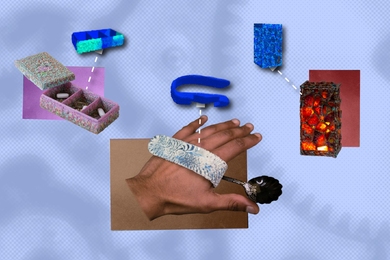Electron microscopes are the most powerful type of microscope, capable of distinguishing even individual atoms. However, these microscopes cannot be used to image living cells because the electrons destroy the samples.
Now, MIT assistant professor Mehmet Fatih Yanik and his student, William Putnam, propose a new scheme that can overcome this limitation by using a quantum mechanical measurement technique that allows electrons to sense objects remotely. Damage would be avoided because the electrons would never actually hit the imaged objects.
Such a non-invasive electron microscope could shed light on fundamental questions about life and matter, allowing researchers to observe molecules inside a living cell without disturbing them. Yanik and Putnam report their new approach in the October issue of Physical Review A — Rapid Communications.
If successful, such microscopes would surmount what Nobel laureate Dennis Gabor concluded in 1956 was the fundamental limitation of electron microscopy: "the destruction of the object by the exploring agent."
Electron flow
Electron microscopes use a particle beam of electrons, instead of light, to image specimens. Resolution of electron microscope images ranges from 0.2 to 10 nanometers — 10 to 1,000 times greater than a traditional light microscope. Electron microscopes can also magnify samples up to two million times, while light microscopes are limited to 2,000 times.
However, biologists have been unable to unleash the high power of electron microscopes on living specimens, because of the destructive power of the electrons.
The radiation dose received by a specimen during electron microscope imaging is comparable to the irradiation from a 10-megaton hydrogen bomb exploded about 30 meters away. When exposed to such energetic electron beams, biological specimens experience rapid breakdown, modification of chemical bonds, or other structural damages.
Although there exist special chambers to keep biological samples in a watery environment within the high vacuum required for electron microscopes, chemical preservation or freezing, which kill cells, is still required before biological samples can be viewed with existing electron microscopes.
In the proposed quantum mechanical setup, electrons would not directly strike the object being imaged. Instead, an electron would flow around one of two rings, arranged one above the other. The rings would be close enough together that the electron could hop easily between them. However, if an object (such as a cell) were placed between the rings, it would prevent the electron from hopping, and the electron would be trapped in one ring.
This setup would scan one "pixel" of the specimen at a time, putting them all together to create the full image. Whenever the electron was trapped, the system would know that there was a dark pixel in that spot.
Though technical challenges would need to be overcome (such as preventing the imaging electron from interacting with electrons of the metals in the microscope), Yanik believes that eventually such a microscope could achieve a few nanometers of resolution. That level of resolution would allow scientists to view molecules such as enzymes in action inside living cells, and even single nucleic acids — the building blocks of DNA.
Yanik, the Robert J. Shillman Career Development Assistant Professor of Electrical Engineering, says he expects the work will launch experimental efforts that could lead to a prototype within the next five years.
Charles Lieber, professor of chemistry at Harvard and an expert in nanoscale technology, describes Yanik's proposal as a "highly original and exciting concept for 'noninvasive' high-resolution imaging" using an electron microscope.
"From my perspective, it has the potential to be a breakthrough for those working with sensitive samples, such as biological imaging," Lieber says. "Also, in general terms I find his work intellectually exciting because it is not incremental but takes a quantum (excuse the pun) jump forward through creative thinking."
Now, MIT assistant professor Mehmet Fatih Yanik and his student, William Putnam, propose a new scheme that can overcome this limitation by using a quantum mechanical measurement technique that allows electrons to sense objects remotely. Damage would be avoided because the electrons would never actually hit the imaged objects.
Such a non-invasive electron microscope could shed light on fundamental questions about life and matter, allowing researchers to observe molecules inside a living cell without disturbing them. Yanik and Putnam report their new approach in the October issue of Physical Review A — Rapid Communications.
If successful, such microscopes would surmount what Nobel laureate Dennis Gabor concluded in 1956 was the fundamental limitation of electron microscopy: "the destruction of the object by the exploring agent."
Electron flow
Electron microscopes use a particle beam of electrons, instead of light, to image specimens. Resolution of electron microscope images ranges from 0.2 to 10 nanometers — 10 to 1,000 times greater than a traditional light microscope. Electron microscopes can also magnify samples up to two million times, while light microscopes are limited to 2,000 times.
However, biologists have been unable to unleash the high power of electron microscopes on living specimens, because of the destructive power of the electrons.
The radiation dose received by a specimen during electron microscope imaging is comparable to the irradiation from a 10-megaton hydrogen bomb exploded about 30 meters away. When exposed to such energetic electron beams, biological specimens experience rapid breakdown, modification of chemical bonds, or other structural damages.
Although there exist special chambers to keep biological samples in a watery environment within the high vacuum required for electron microscopes, chemical preservation or freezing, which kill cells, is still required before biological samples can be viewed with existing electron microscopes.
In the proposed quantum mechanical setup, electrons would not directly strike the object being imaged. Instead, an electron would flow around one of two rings, arranged one above the other. The rings would be close enough together that the electron could hop easily between them. However, if an object (such as a cell) were placed between the rings, it would prevent the electron from hopping, and the electron would be trapped in one ring.
This setup would scan one "pixel" of the specimen at a time, putting them all together to create the full image. Whenever the electron was trapped, the system would know that there was a dark pixel in that spot.
Though technical challenges would need to be overcome (such as preventing the imaging electron from interacting with electrons of the metals in the microscope), Yanik believes that eventually such a microscope could achieve a few nanometers of resolution. That level of resolution would allow scientists to view molecules such as enzymes in action inside living cells, and even single nucleic acids — the building blocks of DNA.
Yanik, the Robert J. Shillman Career Development Assistant Professor of Electrical Engineering, says he expects the work will launch experimental efforts that could lead to a prototype within the next five years.
Charles Lieber, professor of chemistry at Harvard and an expert in nanoscale technology, describes Yanik's proposal as a "highly original and exciting concept for 'noninvasive' high-resolution imaging" using an electron microscope.
"From my perspective, it has the potential to be a breakthrough for those working with sensitive samples, such as biological imaging," Lieber says. "Also, in general terms I find his work intellectually exciting because it is not incremental but takes a quantum (excuse the pun) jump forward through creative thinking."






